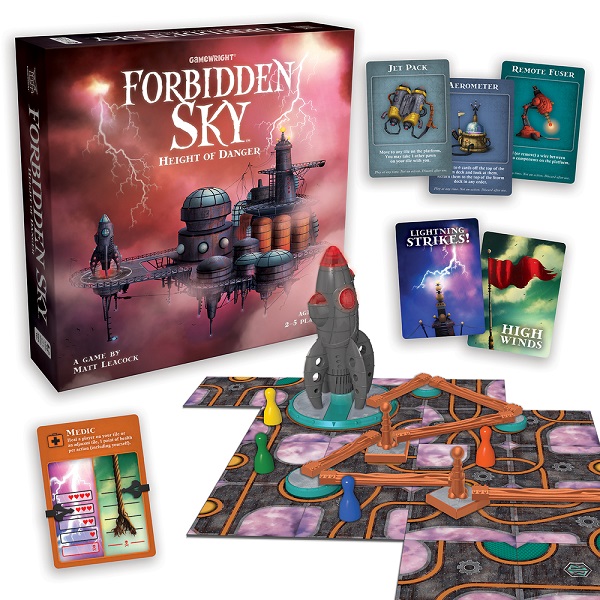Explore, Wire, and Prepare for Takeoff in Forbidden Sky: The Next Step in the Forbidden Adventure

Forbidden Sky puts players miles in the air on a dangerous platform as the winds rage around them and they race to prepare a rocket for takeoff.
As the third game in the hit series that began with Forbidden Island, the question has to be asked: is it worthy of its predecessors?
Gameplay
The goal of the game is to launch the rocket and escape the platform in the sky. Players start by agreeing on a difficulty level. The difficulty level determines how many parts you need to connect in order to launch the rocket. Each player is dealt a random character. Each character has a unique ability such as being able to heal other players or repair their rope. Each player has health and rope strength — if either of these ever hits zero, all players lose the game.
On your turn you may take up to four actions, with four to choose from: move, scout, explore, or wire. Moving allows you to move your pawn from one tile to an adjacent one (never diagonally). Tiles contain both platform and sky and must be connected by platform in order to move between them. If sky connects them, you cannot move across. There are also teleporters on some tiles, and you can use a movement action to move from one teleporter to another. When you scout, you draw a tile from the draw pile (you may hold up to three at a time). When you explore, you may add one of your tiles to an empty space adjacent to the tile your pawn is currently on. Tiles show orange power lines running across them and to play a tile, the power lines must connect to those shown on the tile your pawn occupies.
Tiles can also show lightning rods (in which case you immediately place a rod game piece on the tile) and portions of circles. When placing a tile completes a circle, you place a game piece on the circle depending on the size of said circle (it may be a small or large capacitor, or it may be the launch pad for the rocket).
Finally, the wiring action allows you to place one of the game’s wire game pieces onto the board, connecting any capacitor, lightning rod, or launch pad on your tile to any other within reach of the wire. A maximum of two wires can be connected to any of these components. In order to launch the rocket, players must have wires starting at one end of the launch pad, run through each of the necessary components as listed by the selected difficulty level, and then wrap around to the opposite side of the launch pad. All players must be at the launch pad when the last wire is placed in order to win the game.
At the end of your turn you draw a number of storm cards equal to the level of the storm (cards in the storm deck can cause the storm level to rise). Storm cards can cause lightning to strike, damaging players who are on a tile with a lightning rod or tiles connected by power lines to lightning rods, and wind can blow, moving players from one tile to another (if they would be blown off the board or into patches of sky, they stay where they are and their rope takes one point of damage).

Review
Forbidden Sky keeps certain elements from its predecessors while also implementing new ideas. The tile laying mechanic is fresh to the series, while the storm levels, character roles, and general structure of the turns remain the same.
Each game in the series has always focused on a new element, but the tile laying aspect feels like more of a change in Forbidden Sky than the new elements included in Forbidden Desert. There is also less of the feeling of desperately trying to maintain the map, as you’re not clearing off tiles of sand or floods. Consequently, there is more a sense of exploration in this fantastical environment.
The game itself is more complex than either Forbidden Island or Forbidden Desert — figuring out how the wires and components have to connect and then the best strategy for ensuring that they do, can be tough to grasp. You can also be at a disadvantage if you’re not dealt the right character cards at the start of the game.
Aesthetically, the game has a fun steampunk flavor to it, and the rocket actually lights up and makes sounds when the pieces are correctly connected. This is a fun feature, though it can be a bit fiddly to make it work.
Like all the best cooperative games, you will probably lose but you will also want to keep trying, you want to keep pushing, and you want to pull through those victories by the skin of your teeth. If you’re a fan of the series and open for something a little less streamlined, you will find a lot of fun and challenge in Forbidden Sky. However, if you’re new to the series, or cooperative games in general, this may not be the best place to start.
Pros: Tile laying mechanic is well implemented, the rocket is a neat component, challenging
Cons: More complex than previous games in the series, certain concepts are difficult to grasp, the characters you’re randomly dealt can significantly alter the difficulty
Disclosure: we received a complimentary review copy of this game.







